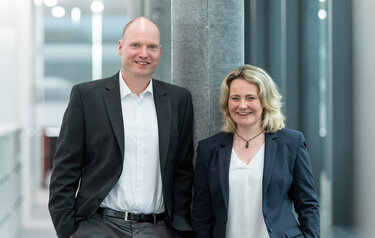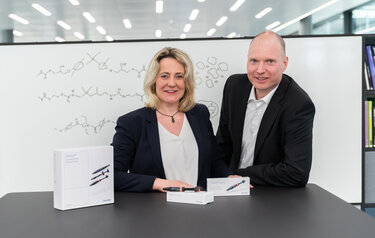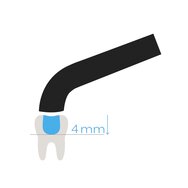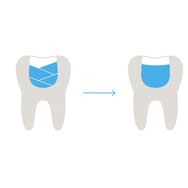Completing routine tasks in a dental practice quickly, reliably and to a high standard can boost efficiency and strengthen the loyalty of patients, making it a beneficial strategy. But how do you achieve this? Bulk-fill composites present a solution here: they simplify the restorative treatment process, reduce the risk of errors, and help save time. Although they have been on the market for over ten years, this type of composite is still not very popular. Why is this the case and what requirements must bulk-fills meet to achieve a breakthrough?
We posed these questions to our experts Anja Stouten from the Product Management department and Dr Benjamin Gebhardt from the Composite Development department at R&D.
Bulk-fill composites enable a streamlined and time-saving restorative workflow and decrease the likelihood of errors compared to the conventional incremental technique. So, why do many dentists continue to favour universal composites and the incremental layering technique despite these benefits?
Anja Stouten: In my view, the main reason why bulk-fills are underrated largely stems from education, as universities continue to teach the conventional filling technique as the gold standard. The bulk-fill technique requires a different approach, which affects the workflow. For instance, the dental team needs to be trained on the materials to be able to lay out the correct products for the procedure. Economic aspects also come into play, as universal composites cut down the number of materials that need to be kept in stock.
What do you think is the biggest reservation dentists harbour about bulk-fill composites?
Anja Stouten: Firstly, they often worry about the esthetic appearance, as the first bulk-fill materials were too translucent. We have addressed this issue with the development of our patented Aessencio technology, which makes the initially translucent composite become more opaque as it undergoes polymerization, resulting in a natural-looking esthetic effect. Additionally, many dentists are still concerned about the depth of cure. They suspect that faster curing may lead to less reliable results. Our response to this is our patented photo initiator Ivocerin. This photo initiator features an enhanced quantum efficiency that acts like a polymerization booster. The material looks esthetic and cures quickly yet reliably. Composite shrinkage stress also presents a significant challenge for dentists. In a context in which the conventional layering technique is considered the gold standard, the shrinkage stress of bulk-fill materials is seen as problematic. Concerns about potential consequences, such as marginal gaps (microleakage) and secondary caries, persist strongly. However, recent studies on bulk-fill composites have revealed a completely different picture, showing them to be comparable to conventional composites.[1-3] By adding our chain controller to Tetric PowerFill, a more uniform polymerization is achieved, reducing shrinkage stress and improving marginal adaptation, while maintaining the material’s proven physical properties.
What possible enhancements could be made to bulk-fill composites from a developer’s perspective?
Dr Benjamin Gebhardt: Even though the esthetic properties of our bulk-full composites are already at a high level, there is still room for improvement. Regarding material shrinkage, our use of the chain controller has been a valuable step forward, but we believe further enhancements can be achieved, especially when considering improvements in performance and the chemical integration of fragments into the matrix. Another area for improvement is increasing the depth of cure. The current 4-mm depth of cure is not sufficient for every cavity; an increase to 6 or even 8 mm would relieve dentists from worrying about the depths of cavities. At the same time, such an increase would also further enhance the reliability when light-curing the materials in shallower cavities.
In which direction do you think composites will develop?
Anja Stouten: As many dentists focus on increasing the efficiency of their practice and procedures as well as streamlining the range of materials, universal composites still hold the top spot in restorative treatments. In my opinion, bulk-fill materials are greatly overlooked in this context, even though they could easily meet so many needs. In recent years, the development of flowable materials has increased in comparison to sculptable ones and I expect this trend to continue. I can imagine that future composites may push the boundaries and/or offer a meaningful blend of conventional and bulk-fill technologies.
Dr Benjamin Gebhardt: The trend towards streamlining and increasing workflow efficiency will definitely continue to grow. Back in my school days, we imagined that one day we would have a device that could do it all: make phone calls, play music, take photos and videos and function like a mini-computer. This has now become a reality in the form of smartphones. In my view, dentists will have access to a universal material that allows them to create all types of restorations reliably and in an esthetically pleasing fashion in the future. Another emerging trend will be the use of ‘smart’ biometric materials. Currently, the surrounding tooth structure and the adjacent teeth to restorations are exposed to elevated levels of acidity. This is because current materials are not as effective as the natural tooth structure (hydroxyapatite) in preventing plaque buildup and buffering elevated levels of acidity. This can lead to more lesions and fillings. Materials that promote natural remineralization processes would greatly benefit patients. Moreover, the downward pressure on prices will continue and less wealthy population groups will have access to esthetic dentistry. This will lead to the development of new treatment concepts and workflows by dentists and the industry. In the process, the distinctions between digital and analog dentistry will become increasingly blurred.
What can we expect from Ivoclar going forwards?
Anja Stouten: After 100 years of innovation, our focus remains on the development of innovative materials. It is important to involve as many users as possible in this process and to tailor our materials to their needs. Expect more innovations that will make your practice life easier in the future, such as our 3s PowerCure product family. Stay tuned and watch this space... .


[1] Lima FG, Romano AR, Correa MB, Demarco FF. Influence of microleakage, surface roughness and biofilm control on secondary caries formation around composite resin restorations: an in situ evaluation. J Appl Oral Sci. 2009 Jan-Feb;17(1):61-5. doi: 10.1590/s1678-77572009000100012. PMID: 19148408; PMCID: PMC4327616.
[2] Magno MB, Nascimento GC, Rocha YS, Ribeiro BD, Loretto SC, Maia LC. Silorane-based Composite Resin Restorations Are Not Better than Conventional Composites - A Meta-Analysis of Clinical Studies. J Adhes Dent. 2016;18(5):375-386. doi: 10.3290/j.jad.a36916. PMID: 27695714.
[3] Arbildo-Vega HI, Lapinska B, Panda S, Lamas-Lara C, Khan AS, Lukomska-Szymanska M. Clinical Effectiveness of Bulk-Fill and Conventional Resin Composite Restorations: Systematic Review and Meta-Analysis. Polymers. 2020; 12(8):1786. https://doi.org/10.3390/polym12081786.



